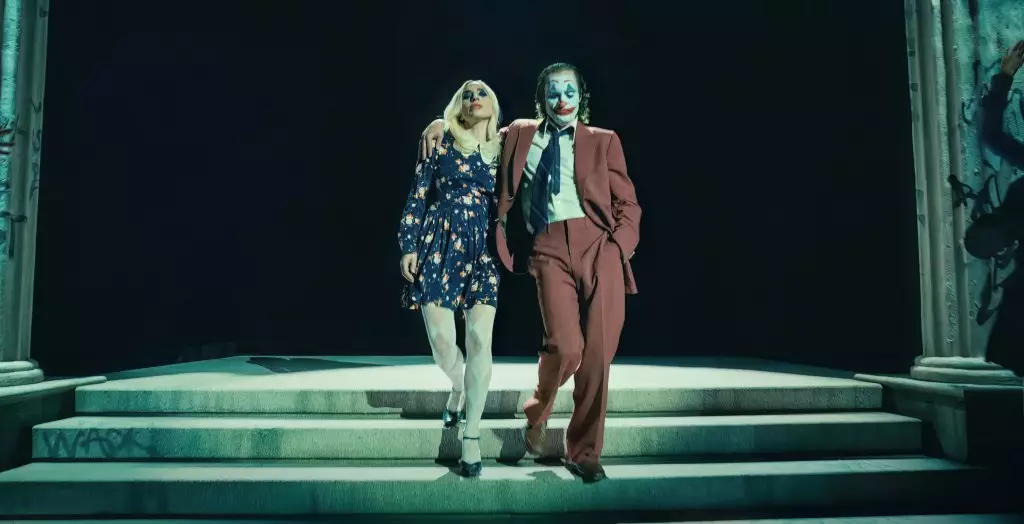The cinematic landscape is one filled with immense expectations, especially when it comes to sequels of blockbuster hits. The recent release of “Joker: Folie à Deux,” directed by Todd Phillips and featuring Joaquin Phoenix and Lady Gaga, serves as a prime example of how a sequel doesn’t always live up to its predecessor’s monumental standards. The film, which premiered in 76 international markets, raked in $81.1 million, leading to a global first-weekend total of $121.1 million. Yet, these figures, impressive on the surface, conceal a deeper narrative of disappointment among increasingly vocal critics and audiences alike.
To gauge the performance of “Folie à Deux,” one must compare it to the original “Joker,” which opened to a staggering $139 million in similar markets and benefited significantly from its Golden Lion win at the Venice Film Festival. While the first installment built its momentum through strong critical reception, the sequel’s Venice premiere did not evoke the same enthusiasm. Falling short on critical and social fronts, it’s evident that this sequel may not replicate the original’s Oscar-winning success. Market analysts speculate that the connection to the Venice premiere might have dampened initial projections, suggesting that a standalone release could have generated greater buzz.
The Spectrum of Critical Reception
Critical reviews for “Joker: Folie à Deux” have been overwhelmingly negative. Ratings from platforms such as France’s Allo Ciné reveal a stark contrast to the first film; the sequel holds a dismal rating of 2.8 from critics and 2.4 from audiences, juxtaposed against the original’s impressive 4.1 and 4.4 ratings respectively. This decline in critical integrity not only hampers the film’s marketability but also reflects a profound disconnection between the narrative’s appeal and audience expectations. Factors such as character development, plot depth, and thematic resonance have been blamed for this lackluster reception, indicating that even star power may not be sufficient to sway public opinion when the underlying content does not resonate.
Despite the unfavorable critique, “Folie à Deux” did manage to top several international charts, with notable performances in the UK ($8 million), Germany ($6.9 million), and Italy ($5.6 million). However, audience scores reveal a troubling trend, especially in key markets like South Korea, where it only managed a disappointing $3.7 million—an alarming dip from the first film’s initial $15 million opening there. While it earned the number one spot across its top five international launches, the overall reception left much to be desired, raising questions about its Scurve in different cultural contexts and how humor, violence, and psychological themes are interpreted globally.
Consumer interest in theaters is not waning; however, “Folie à Deux” fails to resonate as its predecessor did. Rivals in the industry have noted that the excitement surrounding box office attendance remains, but this particular sequel left its core fanbase wanting more. Mixed reviews have created a ripple effect; negative word-of-mouth has actively influenced audience turnout. Ultimately, the film emerged as a cautionary tale of how high expectations, if unmet, can lead to consumer disillusionment—a factor that the industry must take note of moving forward.
Financial Implications for the Franchise
The question now looms over Warner Bros.: can “Joker: Folie à Deux” recoup its investment? With projections for the final take looking increasingly suspect, comparisons to its groundbreaking predecessor are inevitable. Discussions of box office performance often align with projections for future sequels or related franchise ventures, making it crucial for the studio to reassess their strategies in developing content that aligns with audience anticipation and demand.
In stark contrast to “Joker: Folie à Deux,” other Warner Bros. projects like “Beetlejuice Beetlejuice” showcased resilience, surpassing $400 million worldwide. This serves as a reminder that while one high-profile release may falter, the cinematic ecosystem is resilient, continuously presenting opportunities for films to thrive based on varied thematic content and market approach.
The contrasting receptions of “Joker: Folie à Deux” and its predecessor illustrate a vital lesson for the film industry: a successful franchise requires more than just star power or a prompt sequel; it necessitates a connection that resonates deeply with its audience. Warner Bros. and other studios must strategically navigate these waters as they consider future projects in an evolved landscape.

